Page 326 of 474
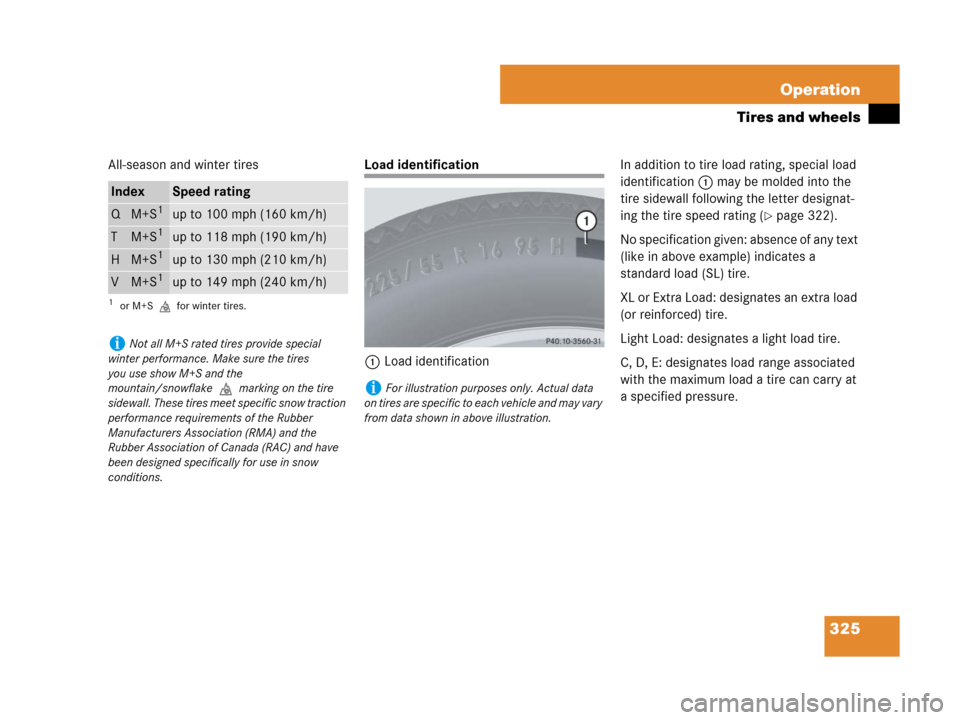
325 Operation
Tires and wheels
All-season and winter tiresLoad identification
1Load identificationIn addition to tire load rating, special load
identification 1 may be molded into the
tire sidewall following the letter designat-
ing the tire speed rating (
�page 322).
No specification given: absence of any text
(like in above example) indicates a
standard load (SL) tire.
XL or Extra Load: designates an extra load
(or reinforced) tire.
Light Load: designates a light load tire.
C, D, E: designates load range associated
with the maximum load a tire can carry at
a specified pressure.
IndexSpeed rating
QM+S1
1or M+S.for winter tires.
up to 100 mph (160 km/h)
TM+S1up to 118 mph (190 km/h)
HM+S1up to 130 mph (210 km/h)
VM+S1up to 149 mph (240 km/h)
iNot all M+S rated tires provide special
winter performance. Make sure the tires
you use show M+S and the
mountain/snowflake.marking on the tire
sidewall. These tires meet specific snow traction
performance requirements of the Rubber
Manufacturers Association (RMA) and the
Rubber Association of Canada (RAC) and have
been designed specifically for use in snow
conditions.
iFor illustration purposes only. Actual data
on tires are specific to each vehicle and may vary
from data shown in above illustration.
Page 336 of 474
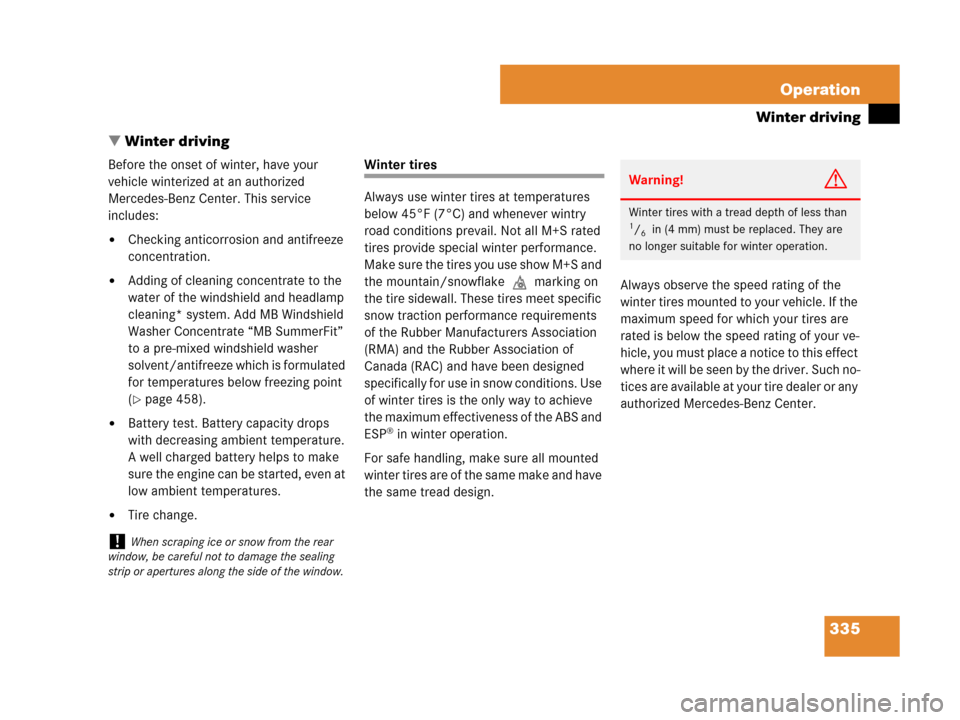
335 Operation
Winter driving
�Winter driving
Before the onset of winter, have your
vehicle winterized at an authorized
Mercedes-Benz Center. This service
includes:
�Checking anticorrosion and antifreeze
concentration.
�Adding of cleaning concentrate to the
water of the windshield and headlamp
cleaning* system. Add MB Windshield
Washer Concentrate “MB SummerFit”
to a pre-mixed windshield washer
solvent/antifreeze which is formulated
for temperatures below freezing point
(
�page 458).
�Battery test. Battery capacity drops
with decreasing ambient temperature.
A well charged battery helps to make
sure the engine can be started, even at
low ambient temperatures.
�Tire change.
Winter tires
Always use winter tires at temperatures
below 45°F (7°C) and whenever wintry
road conditions prevail. Not all M+S rated
tires provide special winter performance.
Make sure the tires you use show M+S and
the mountain/snowflake.marking on
the tire sidewall. These tires meet specific
snow traction performance requirements
of the Rubber Manufacturers Association
(RMA) and the Rubber Association of
Canada (RAC) and have been designed
specifically for use in snow conditions. Use
of winter tires is the only way to achieve
the maximum effectiveness of the ABS and
ESP
® in winter operation.
For safe handling, make sure all mounted
winter tires are of the same make and have
the same tread design.Always observe the speed rating of the
winter tires mounted to your vehicle. If the
maximum speed for which your tires are
rated is below the speed rating of your ve-
hicle, you must place a notice to this effect
where it will be seen by the driver. Such no-
tices are available at your tire dealer or any
authorized Mercedes-Benz Center.
!When scraping ice or snow from the rear
window, be careful not to damage the sealing
strip or apertures along the side of the window.
Warning!G
Winter tires with a tread depth of less than 1/6 in (4 mm) must be replaced. They are
no longer suitable for winter operation.
Page 349 of 474
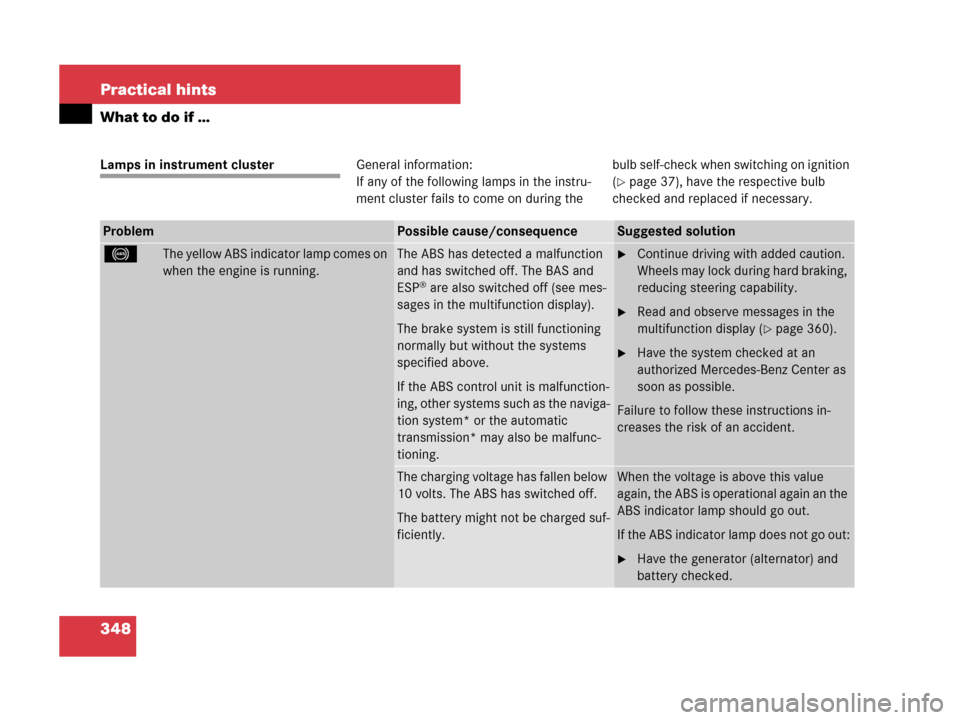
348 Practical hints
What to do if …
Lamps in instrument clusterGeneral information:
If any of the following lamps in the instru-
ment cluster fails to come on during thebulb self-check when switching on ignition
(
�page 37), have the respective bulb
checked and replaced if necessary.
ProblemPossible cause/consequenceSuggested solution
-The yellow ABS indicator lamp comes on
when the engine is running.The ABS has detected a malfunction
and has switched off. The BAS and
ESP
® are also switched off (see mes-
sages in the multifunction display).
The brake system is still functioning
normally but without the systems
specified above.
If the ABS control unit is malfunction-
ing, other systems such as the naviga-
tion system* or the automatic
transmission* may also be malfunc-
tioning.
�Continue driving with added caution.
Wheels may lock during hard braking,
reducing steering capability.
�Read and observe messages in the
multifunction display (
�page 360).
�Have the system checked at an
authorized Mercedes-Benz Center as
soon as possible.
Failure to follow these instructions in-
creases the risk of an accident.
The charging voltage has fallen below
10 volts. The ABS has switched off.
The battery might not be charged suf-
ficiently.When the voltage is above this value
again, the ABS is operational again an the
ABS indicator lamp should go out.
If the ABS indicator lamp does not go out:
�Have the generator (alternator) and
battery checked.
Page 350 of 474
349 Practical hints
What to do if …
ProblemPossible cause/consequenceSuggested solution
-The yellow ABS indicator lamp comes on
when the engine is running.The ABS is temporary not available.
The ESP® and the BAS are also un-
available.
The system’s self-diagnosis may not
be completed yet.
The brake system is still functioning
normally but without the systems
specified above.
�Drive a short distance with added
caution at a vehicle speed of above
12 mph (20 km/h).
When the ABS indicator lamp goes
out, the ABS, the ESP
®, and the BAS
are available again.
If the yellow ABS indicator lamp does not
go out:
�Continue driving with added caution.
�Have the system checked at an
authorized Mercedes-Benz Center as
soon as possible.
Failure to follow these instructions
increases the risk of an accident.
Page 363 of 474
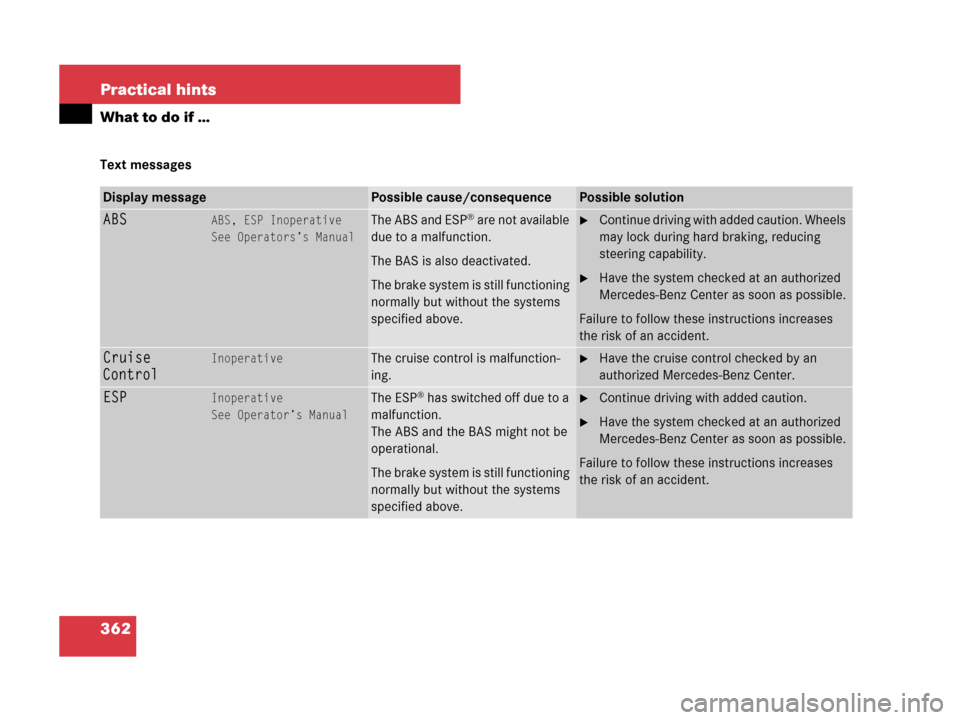
362 Practical hints
What to do if …
Text messages
Display messagePossible cause/consequencePossible solution
ABSABS, ESP Inoperative
See Operators’s ManualThe ABS and ESP® are not available
due to a malfunction.
The BAS is also deactivated.
The brake system is still functioning
normally but without the systems
specified above.�Continue driving with added caution. Wheels
may lock during hard braking, reducing
steering capability.
�Have the system checked at an authorized
Mercedes-Benz Center as soon as possible.
Failure to follow these instructions increases
the risk of an accident.
Cruise
ControlInoperativeThe cruise control is malfunction-
ing.�Have the cruise control checked by an
authorized Mercedes-Benz Center.
ESPInoperative
See Operator’s ManualThe ESP® has switched off due to a
malfunction.
The ABS and the BAS might not be
operational.
The brake system is still functioning
normally but without the systems
specified above.�Continue driving with added caution.
�Have the system checked at an authorized
Mercedes-Benz Center as soon as possible.
Failure to follow these instructions increases
the risk of an accident.
Page 364 of 474
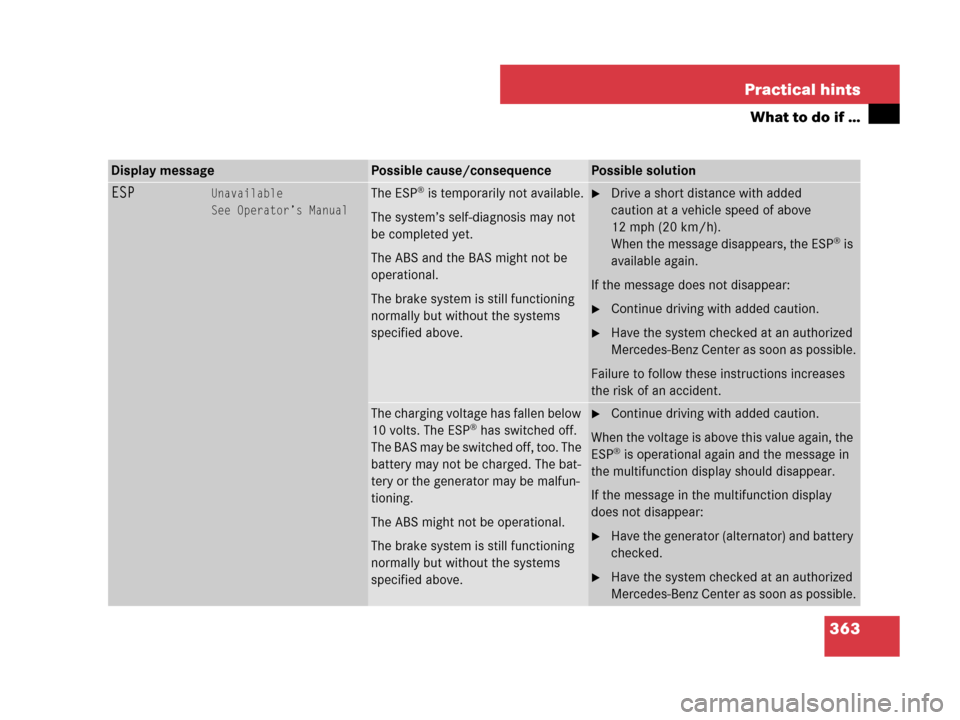
363 Practical hints
What to do if …
Display messagePossible cause/consequencePossible solution
ESPUnavailable
See Operator’s ManualThe ESP® is temporarily not available.
The system’s self-diagnosis may not
be completed yet.
The ABS and the BAS might not be
operational.
The brake system is still functioning
normally but without the systems
specified above.�Drive a short distance with added
caution at a vehicle speed of above
12 mph (20 km/h).
When the message disappears, the ESP
® is
available again.
If the message does not disappear:
�Continue driving with added caution.
�Have the system checked at an authorized
Mercedes-Benz Center as soon as possible.
Failure to follow these instructions increases
the risk of an accident.
The charging voltage has fallen below
10 volts. The ESP® has switched off.
The BAS may be switched off, too. The
battery may not be charged. The bat-
tery or the generator may be malfun-
tioning.
The ABS might not be operational.
The brake system is still functioning
normally but without the systems
specified above.
�Continue driving with added caution.
When the voltage is above this value again, the
ESP
® is operational again and the message in
the multifunction display should disappear.
If the message in the multifunction display
does not disappear:
�Have the generator (alternator) and battery
checked.
�Have the system checked at an authorized
Mercedes-Benz Center as soon as possible.
Page 393 of 474
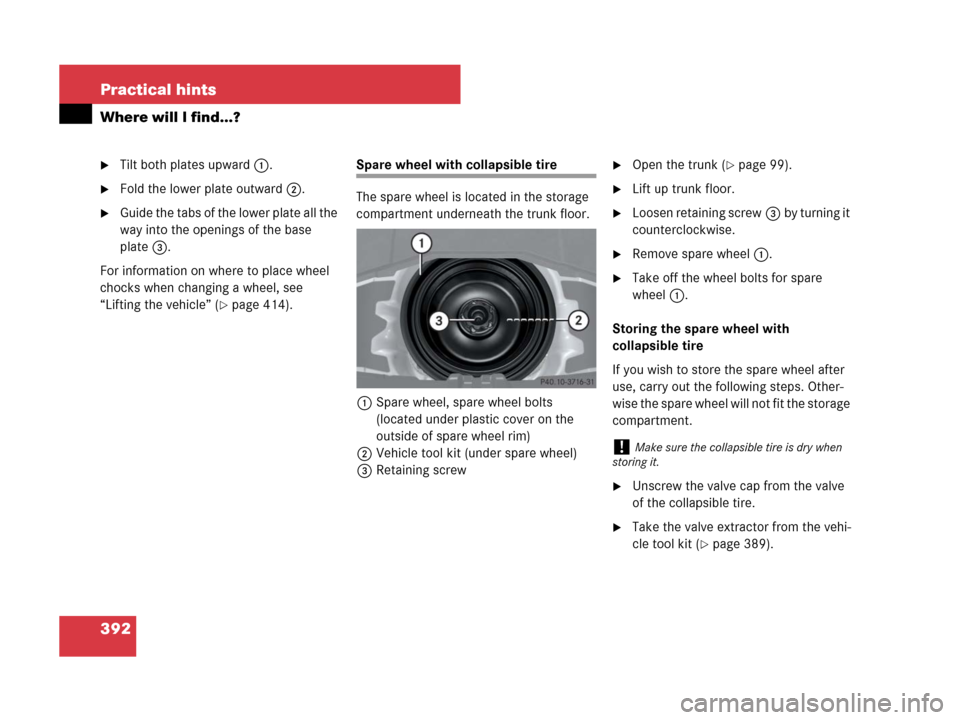
392 Practical hints
Where will I find...?
�Tilt both plates upward1.
�Fold the lower plate outward2.
�Guide the tabs of the lower plate all the
way into the openings of the base
plate3.
For information on where to place wheel
chocks when changing a wheel, see
“Lifting the vehicle” (
�page 414).
Spare wheel with collapsible tire
The spare wheel is located in the storage
compartment underneath the trunk floor.
1Spare wheel, spare wheel bolts
(located under plastic cover on the
outside of spare wheel rim)
2Vehicle tool kit (under spare wheel)
3Retaining screw�Open the trunk (�page 99).
�Lift up trunk floor.
�Loosen retaining screw3by turning it
counterclockwise.
�Remove spare wheel1.
�Take off the wheel bolts for spare
wheel1.
Storing the spare wheel with
collapsible tire
If you wish to store the spare wheel after
use, carry out the following steps. Other-
wise the spare wheel will not fit the storage
compartment.
�Unscrew the valve cap from the valve
of the collapsible tire.
�Take the valve extractor from the vehi-
cle tool kit (
�page 389).
!Make sure the collapsible tire is dry when
storing it.
Page 408 of 474
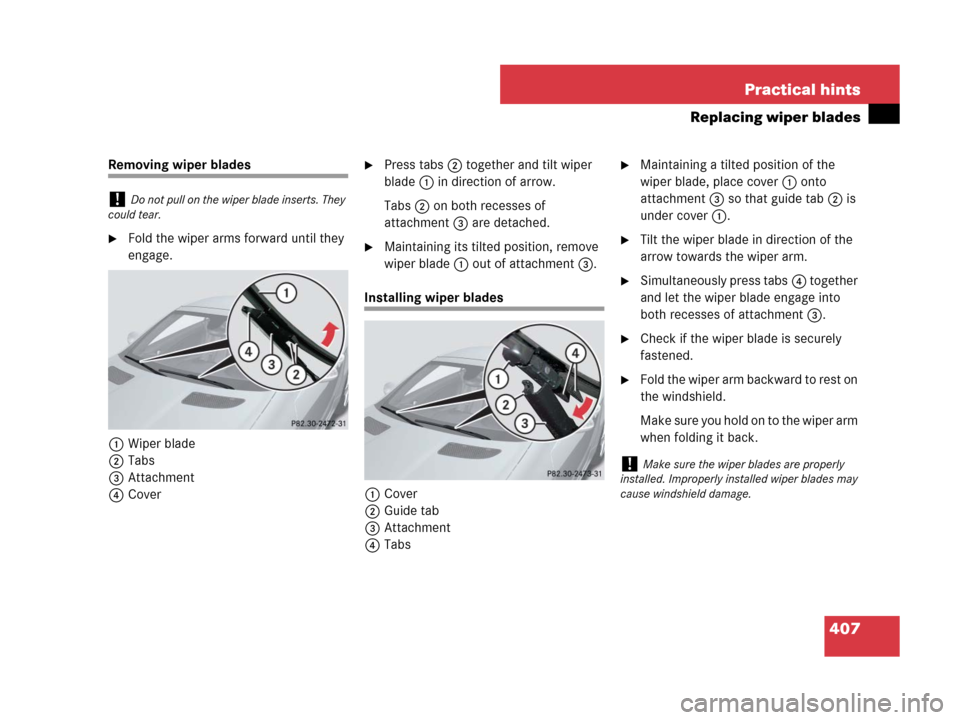
407 Practical hints
Replacing wiper blades
Removing wiper blades
�Fold the wiper arms forward until they
engage.
1Wiper blade
2Tabs
3Attachment
4Cover
�Press tabs2 together and tilt wiper
blade1 in direction of arrow.
Tabs2 on both recesses of
attachment3 are detached.
�Maintaining its tilted position, remove
wiper blade1 out of attachment3.
Installing wiper blades
1Cover
2Guide tab
3Attachment
4Tabs
�Maintaining a tilted position of the
wiper blade, place cover1 onto
attachment3 so that guide tab2 is
under cover1.
�Tilt the wiper blade in direction of the
arrow towards the wiper arm.
�Simultaneously press tabs4 together
and let the wiper blade engage into
both recesses of attachment3.
�Check if the wiper blade is securely
fastened.
�Fold the wiper arm backward to rest on
the windshield.
Make sure you hold on to the wiper arm
when folding it back.
!Do not pull on the wiper blade inserts. They
could tear.
!Make sure the wiper blades are properly
installed. Improperly installed wiper blades may
cause windshield damage.